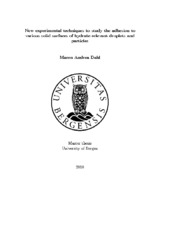| dc.description.abstract | Hydrate plugging is a substantial problem in the oil and gas industry, both economically, environmentally and safety wise. Plugging may occur as a result of agglomeration of hydrate particles, deposition of hydrates on the pipeline wall, large hydrate particle loadings or a combination of the three. It would be an advantage to have the hydrates following the flow as a dispersion, instead of agglomerating and depositing onto the pipeline wall. This would prevent plugging. To do this, knowledge about the force between the hydrate and the pipeline material is required; A reduction in the brinewall adhesive force is likely to indicate that the pipeline is less subjected to hydrate deposition. In this work, the forces between hydrates or droplets of brine were investigated in various ways. A stirred beaker setup was developed to easily investigate the effect of flow on hydrate deposition. The goal was to create a large data set of the flow rate required to detach a hydrate particle or droplet from various surfaces. To do this, a flow loop is often involved, but such a setup has been found difficult use for this purpose. A setup where the surface material could be easily changed was required and developed. The setup lived up to its expectations, but has to be refined. The model used in these experiments was 15 wt% TBAB (Tetrabutylammonium bromide) in petroleum ether, and the solid surfaces investigated were glass, stainless steel, aluminum, brass and epoxy. The static contact angles of brine of different surfaces were measured, and the results were used to calculate the adhesion energy. It was found that the epoxy surface is the only oil-wet surface, with a low adhesion energy. The brass surface is slightly water-wet, while glass, stainless steel and aluminum all have low contact angles, and corresponding high adhesion energy. This indicates that a water droplet will adhere less strongly to a epoxy surface, compared to the other surfaces in question. Hydrates, in form of brine, hydrates grown on a surface and deposited hydrates, with and without acid in the oil phase, were tried detached from different surfaces, using the stirred beaker setup. A CFD model of the setup was used to determine the velocity of the fluid over the particle, and the drag force acting on the particle was calculated. It was found that the force needed to detach a water droplet and a deposited hydrate follows the trend of the calculated adhesion force between the solid surfaces and brine. It was also found that a hydrate grown on a surface adheres very strongly to the surface, while a deposited dry particle adhere very poorly. A wet hydrate, on the other hand, detaches at the same Reynolds number as a droplet of brine, which indicates that capillary forces are the governing adhesion mechanism. The stirred beaker setup was used to measure the dynamic contact angles of droplets of brine on various surface. An algorithm was used to calculated the force needed to dislodge the droplets. This force followed the trend of the calculated adhesion force between brine and the solid surfaces. There was reason to believe that the calculated forces were not correct, however, the fact that they followed the trend indicates that the setup can be used to make a trend. To calculated the exact forces, the algorithm has to be further developed. | en_US |
